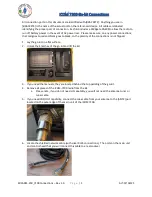
NEO-M9N - Integration manual
u-center application. RTCM corrections from a virtual reference service are also supported by the u-
center NTRIP client.
3.1.6 Legacy configuration interface compatibility
Although there is some backwards compatibility for the legacy UBX-CFG configuration messages,
users are strongly advised to adopt the configuration interface described in this document.
See Legacy UBX-CFG message fields reference section in the applicable interface description [
].
3.1.7 Navigation configuration
This section presents various configuration options related to the navigation engine. These options
can be configured through CFG-NAVSPG-* configuration keys.
3.1.7.1 Platform settings
u-blox receivers support different dynamic platform models (see the table below) to adjust the
navigation engine to the expected application environment. These platform settings can be
changed dynamically without performing a power cycle or reset. The settings improve the receiver's
interpretation of the measurements and thus provide a more accurate position output. Setting the
receiver to an unsuitable platform model for the given application environment is likely to result in
a loss of receiver performance and position accuracy.
The dynamic platform model can be configured through the CFG-NAVSPG-DYNMODEL
configuration item. The supported dynamic platform models and their details can be seen in
below.
Platform
Description
Portable (default)
Applications with low acceleration, e.g. portable devices. Suitable for most situations.
Stationary
Used in timing applications (antenna must be stationary) or other stationary applications.
Velocity restricted to 0 m/s. Zero dynamics assumed.
Pedestrian
Applications with low acceleration and speed, e.g. how a pedestrian would move. Low
acceleration assumed.
Automotive
Used for applications with equivalent dynamics to those of a passenger car. Low vertical
acceleration assumed.
At sea
Recommended for applications at sea, with zero vertical velocity. Zero vertical velocity assumed.
Sea level assumed.
Airborne <1g
Used for applications with a higher dynamic range and greater vertical acceleration than a
passenger car. No 2D position fixes supported.
Airborne <2g
Recommended for typical airborne environments. No 2D position fixes supported.
Airborne <4g
Only recommended for extremely dynamic environments. No 2D position fixes supported.
Wrist
Only recommended for wrist-worn applications. Receiver will filter out arm motion.
Table 3: Dynamic platform models
Platform
Max altitude [m]
Max horizontal
velocity [m/s]
Max vertical velocity
[m/s]
Sanity check type
Max
position
deviation
Portable
12000
310
50
Altitude and velocity
Medium
Stationary
9000
10
6
Altitude and velocity
Small
Pedestrian
9000
30
20
Altitude and velocity
Small
Automotive
6000
100
15
Altitude and velocity
Medium
At sea
500
25
5
Altitude and velocity
Medium
Airborne <1g
80000
100
6400
Altitude
Large
UBX-19014286 - R07
3 Receiver functionality
Page 11 of 95
C1-Public












































